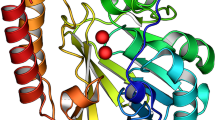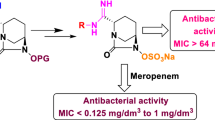Abstract
The most important mechanism of the beta-lactam antibiotic resistance is the destruction of the antibiotics by the enzyme beta-lactamase. Use of beta-lactamase inhibitors in combination with antibiotics is one of the successful antibacterial strategies. The inhibitory effect of a phytochemical, 1,4-naphthalenedione, isolated from the plant Holoptelea integrifolia on beta-lactamase is reported here. This compound was found to have a synergistic effect with the antibiotic amoxicillin against a resistant strain of Staphylococcus aureus. The enzyme was purified from the organism and incubated with the compound. An assay showed that the compound can inhibit the enzymatic activity of beta-lactamase. Modeling and molecular docking studies indicated that the compound can fit into the active site of beta-lactamase. Hence, the compound can serve as a potential lead compound for the development of effective beta-lactamase inhibitor that can be used against beta-lactam-resistant microbial strains.





Similar content being viewed by others
References
Barlett, J. G. (2004). Pocket book of infectious disease therapy. London: Lippincott Williams and Wilkins.
Chambers, H. F., & Neu, H. C. (1995). Penicillins. In G. L. Mandell, J. E. Bennett & R. Dolin (Eds.), Principles and practice of infectious disease (pp. 233–246). New York: Churchill Livingstone.
Moellering, R. C. (1993). Meeting the challenges of beta-lactamases. The Journal of Antimicrobial Chemotherapy, 31, 1–8. doi:10.1093/jac/31.1.1.
Garcia-Rodrignez, J. A., & Jones, R. N. (2002). Antimicrobial resistance in gram-negative isolates from European intensive care unit: data from the Meropenem Yearly Susceptibility Test information Collection (MYSTIC) programme. Journal of Chemotherapy (Florence, Italy), 14, 25–32.
Charles, W., & Stratton, M. D. (1996). Antimicrobics and infectious diseases. News Letter, 15, 51–53.
Bush, K. (1988). Beta-lactamase inhibitors from laboratory to clinic. Clinical Microbiology Reviews, 1, 109–123.
Hutchison, L. C., & Norman, R. A. (2003). Antibiotics and resistance in dermatology: focus on treating the elderly. Dermatologic Therapy, 16, 206–213. doi:10.1046/j.1529-8019.2003.01630.x.
Betoni, J. E. C., Mantovani, R. P., Barbosa, L. N., Di Stasi, L. C., & Fernandes, A., Jr. (2006). Synergism between plant extract and antimicrobial drugs used on S. aureus diseases. Memorias do Instituto Oswaldo Cruz, Rio de Janeiro, 101, 387–390.
Zygmunt, D. J., Stratton, C. W., & Kernodle, D. S. (1992). Characterization of four beta-lactamases produced by Staphylococcus aureus. Antimicrobial Agents and Chemotherapy, 36, 440–445.
Jagtap, S. B., Patil, N. N., Kupadnis, B. P., & Kulkarni, B. A. (2001). Characterization and antimicrobial activity of Erbium (III) Complexes of C-3 Substituted 2-hydroxy-1, 4-naphthalenedione-1-oxime derivatives. Journal of Metal Based Drugs, 8, 159–164.
Ball, M. D., Bartlett, M. S., Shaw, M., Smith, J. W., Nasr, M., & Meshnick, S. R. (2001). Activities and conformational fitting of 1, 4-naphthoquinone derivatives and other cyclic 1, 4-diones tested in vitro against Pneumocystis carinii. Antiicrobial Agents and Chemotherapy, 45, 1473–1479.
Lowry, O. H., Rosebrough, N. J., Farr, A. L., & Randall, R. J. (1951). Protein measurement with the Folin phenol reagent. The Journal of Biological Chemistry, 193, 265–275.
Livermore, D. M., & Yang, Y. J. (1987). Beta-lactamase lability and inducer power of newer beta-lactam antibiotics in relation to their activity against beta-lactamase inducibility mutants of P. aeruginosa. The Journal of Infectious Diseases, 155, 775–782.
Perret, C. J. (1995). Iodometric assay of penicillinase. Nature, 174, 1012–1013. doi:10.1038/1741012a0.
Halgren, T. A. (1996). Merck molecular force field. I. Basis, form, scope, parameterization, and performance of MMFF94. Journal of Computational Chemistry, 17, 490–519. doi:10.1002/(SICI)1096-987X(199604)17:5/6<490::AID-JCC1>3.0.CO;2-P.
Fletcher, R. (1980). Practical methods of optimization: Unconstrained optimization (pp. 417–436). New York: Wiley.
Brooks, B. R., Bruccoleri, R. E., Olafson, B. D., States, D. J., Swaminathan, S., & Karplus, M. (1983). CHARMM: a program for macromolecular energy minimization and dynamics calculations. Journal of Computational Chemistry, 4, 187–217. doi:10.1002/jcc.540040211.
Acknowledgements
The Bioinformatics Infrastructure Facility (funded by the Department of Biotechnology, Government of India) in the department is gratefully acknowledged for providing the computational facility.
Author information
Authors and Affiliations
Corresponding author
Rights and permissions
About this article
Cite this article
Vinod, N.V., Shijina, R., Dileep, K.V. et al. Inhibition of Beta-Lactamase by 1,4-Naphthalenedione from the Plant Holoptelea integrifolia . Appl Biochem Biotechnol 160, 1752–1759 (2010). https://doi.org/10.1007/s12010-009-8656-2
Received:
Accepted:
Published:
Issue Date:
DOI: https://doi.org/10.1007/s12010-009-8656-2




